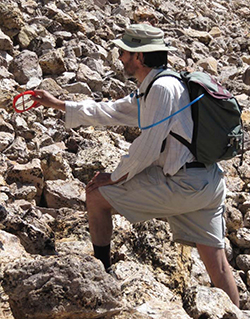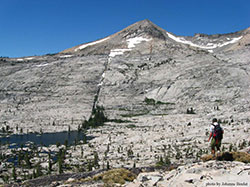
David Wright uses a mirror to reflect light into dark rock crevices in search of pika sign such as scat or urine stains. CDFW image by Joseph Stewart.

Joseph Stewart hikes through one of the mountainous locations in the northern Sierra Nevada that researchers searched for habitat that appeared suitable for pikas. CDFW image by Johanne Boulat.
CDFW staff recently conducted a study to determine whether American pika in California are able to find sufficient refuge from elevated temperatures in their natural habitat. Previous CDFW collaborative research and related work has suggested that pikas in California and Nevada have been declining in warmer areas, but some scientists contend that underground temperature refuges will protect pikas from warming temperature trends.
“The question of whether pikas are protected or exposed to warming temperatures seemed key to us,” said David Wright, a retired CDFW senior environmental scientist who co-authored the research with Joseph Stewart, a former CDFW scientific aid and now a University of California, Davis post-doctoral researcher. “It is central to whether or not climate change is going to push pikas to higher, cooler elevations and significantly reduce and fragment their range, in our state, on our watch.”
Pikas are small herbivores related to rabbits that live in fields of broken rock (talus) in the mountains of western North America. Researchers examined 46 mountainous locations in the northern Sierra Nevada with habitat that appeared suitable for pikas.
Pikas prefer talus with rocks eight inches to three feet in size, and larger or less isolated talus fields are generally more likely to support pikas.
“We did our research at elevations both within and below the expected elevation range of pikas,” Wright said. “Lower elevations on average have warmer temperatures, which pikas don't tolerate well, but it's been suggested that talus provides a refuge from warmer temperatures. We wanted to look at this hypothesis.”
Two species of pika occur in North America, with only the American pika found within the continental U.S. With their high metabolic rates and thick fur (including inside their ears and on the bottoms of their feet), American pikas are well adapted to cold temperatures at high elevations. They do not hibernate during the winter, and spend the summer gathering grasses and wildflowers to store in “haypiles” for subsistence during the winter. Hikers may know them from their distinctive alarm call, a high-pitched cross between a chirp and a bark.
In 2010 to 2013, using small, year-round temperature recorders lowered approximately 1.6 feet to 3.3 feet into talus, along with visual surveys for pikas or signs of pikas, Wright and Stewart found that temperatures below the talus surface were buffered from warm and cold extremes of ambient air temperature. This was consistent with previous findings.
However, pikas were not found wherever talus temperatures were suitable. Temperatures within talus were mostly suitable for pikas across all the study sites regardless of elevation, yet pikas were absent from many of the sites. Instead, summer air temperatures proved to be the best predictor of pika presence or absence. The warmest sites had no evidence of pikas, followed by warm sites that had only remnant fecal pellets (pika pellets can persist among the rocks for decades), then slightly cooler sites that supported pikas in some years but not in others, to the coolest sites which supported persistent populations of pikas throughout the study.
“It’s not enough to have suitable temperatures in their underground burrows,” said Stewart. “Pikas also need suitable temperatures above ground where they forage for food.”
The authors concluded, based on their own and other research, that daily warm air temperatures may inhibit pika foraging and survival because they cannot tolerate the heat, and juvenile survival and dispersal may be similarly impaired by elevated summer high temperatures. Talus provides a cool refuge for pikas up to a point, but beyond that point pikas still need to forage and complete the portions of their life cycle that occur aboveground. This balance point, from this research, appears to be near an average warm season (June to September) air temperature of 71 to 73 degrees.
Funding for this research and similar CDFW efforts in the Sierra Nevada are supported by State Wildlife Grants administered through the U.S. Fish and Wildlife Service.
 The study, Within-talus temperatures are not limiting for pikas in the northern Sierra Nevada, California, USA, can be viewed here (PDF).
The study, Within-talus temperatures are not limiting for pikas in the northern Sierra Nevada, California, USA, can be viewed here (PDF).
CDFW Photos. Top Photo: Pikas are small herbivores that live in fields of broken rock (talus) in the mountains of western North America. CDFW image by Jan Dawson.
Media Contact:
Kyle Orr, CDFW Communications, (916) 322-8958